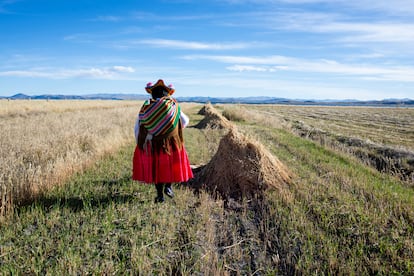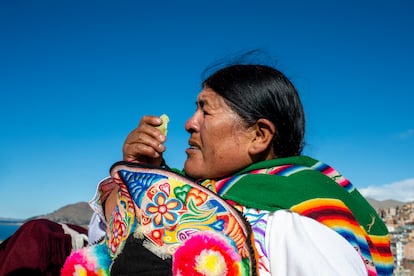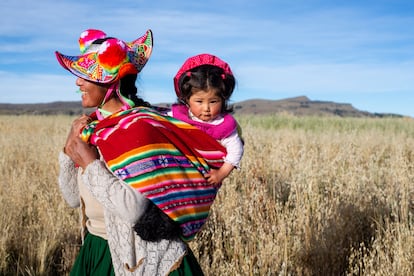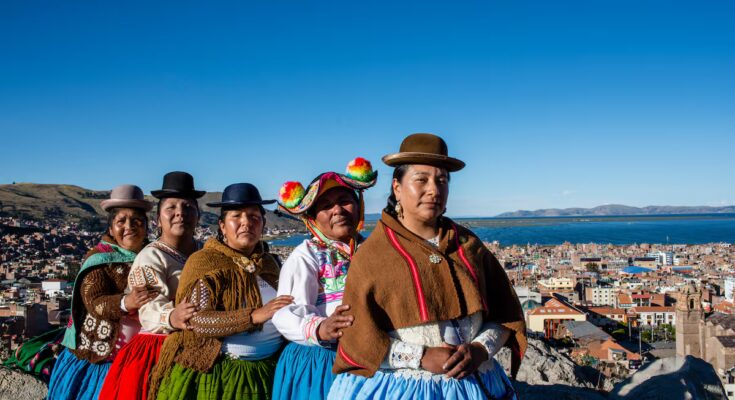“Does the lake speak? Does it breathe? Does it have life? Yes, for us it does,” says Soraya Poma, president of the Network of Women in Defense of Lake Titicaca. At 40, with a determined look and braided hair, Poma leads the group which brings together 45 members from different locations in the Puno region, Peru. At 3,827 meters above sea level, these women are not only united by their concern about pollution, but also by their connection to their culture and their descendants. “(The lake) is sick. The fish are disappearing. It is a big concern. This is why we are fighting. What awaits our future generations?”, he says.
Recently, the environmental struggle of these women has written a new chapter. Thanks to their efforts, today Lake Titicaca is officially recognized as a subject of law, a legal instrument promoted by these indigenous leaders to protect the highest navigable lake in the world.
Since 2024, the network’s leaders had been working on an ordinance that aimed to repair and prevent eventual environmental collapse. With perseverance, this group of women managed to get the Puno Regional Council to vote unanimously, at the end of April 2025, in favor of approving a regional ordinance through which Titicaca could have legal personality. However, after the initial enthusiasm, statements immediately circulated from different levels of the Peruvian government questioning the measure, citing a conflict of powers.
Despite opposition and delays, the ordinance was voted on a second time in the Regional Council and, once again, won. This victory was officially promulgated with the publication of the ordinance on September 20 in the Official Gazette El Peruano.
As part of this outcome, it is emphasized that this measure of legal protection is based on the “customary law of indigenous peoples”, which recognizes the norms and customs that govern the community life of native cultures. With it, Lake Titicaca now regains its ancient right to exist.
“We went through everything in this process. We had moments of joy, anger and worry,” Poma recalls. Leaders know that passing the ordinance is the first step in a long journey. They are currently working on the rules for implementing the ordinance and are visiting rural towns in the region to inform the Quechua and Aymara population. In the medium term, the Network is evaluating the possibility of converting the ordinance into a national bill.
“We cannot wait until the entire lake is contaminated. The state environmental protection policy must be preventive”, warns lawyer Julio Mejía Tapia, a legal specialist who accompanies the leaders together with the Bartolomé de Las Casas Center. “The ordinance implies abandoning the anthropocentric relationship, according to which we protect the environment only because it is convenient for us,” he adds. Consequently, faced with possible contaminating activities, it would be the organizations representing the lake that would request restoration or remediation mechanisms. Authorities, communities or groups, such as the Women’s Network in Defense of Lake Titicaca, may represent you legally.
This measure offers hope to the Peruvian side of the Titicaca, where ecosystems are in danger due to mining, sewage and waste polluting its tributaries. In the monitoring of the National Environmental Information System (SINIA), it emerged that the concentrations of heavy metals in water are “associated with the local geological composition, the presence of mining environmental liabilities and the development of mining activities”. For example, the Ramis, Coata, Ilave, Huancané, and Suches rivers are the main tributaries that flow into the Peruvian side of the lake, contributing 85% of the basin’s total surface water volume. All, without exception, carry heavy metals. From the highlands they travel hundreds of kilometers, passing through mines, crops, communities and cities until they reach Titicaca, according to a 2022 survey conducted by the Binational Autonomous Authority of Lake Titicaca.
Legal and environmental protection
In addition to its relevance in terms of biodiversity – with more than 105 species of birds, 15 mammals and 26 endemic fish – Titicaca is one of the cultural epicenters of the Andes. The chronicles of the Inca Garcilaso de la Vega published at the beginning of the 17th century recount the myth that tells how the founding couple of the Inca empire emerged from its waters.

“We have always known that the lake is sacred, from our grandfathers and grandmothers. For this reason we must protect it and, for this reason, we promoted the ordinance”, says Rosa Copa, treasurer of the Network and Quechua leader of the peasant community of Hilata, on the Capachica peninsula. There, according to the Puno Public Health Network, about 40% of the population exceeds the maximum allowable limits for metals in the blood, especially arsenic. Copa prefers not to take exams.
The lake is sick. The fish are disappearing. It’s a big concern. That’s why we’re fighting. What awaits our future generations?
Soraya Poma, president of the Network of Women in Defense of Lake Titicaca
These leaders know that passing the regulation is just the first step. They will closely observe the efforts of the “sisters”, as they call each other, of the Bolivian side and of the Kukama women, who managed to have the Marañón river recognized as a subject of law against oil spills in the Peruvian Amazon in 2024. Small but significant changes that begin to align Peru with the environmental legislation of Ecuador and Bolivia. However, this group is ahead of the opposition in its execution and implementation. “After the approval of the ordinance, there will be resistance from the central government in its implementation,” predicts Mejía.

Mining under the magnifying glass
Added to the ecological alarm in Titicaca is the recent declaration of environmental emergency due to the presence of illegal and informal mining activities in Puno. Although it will be concentrated in seven provinces, the measure will be applied throughout the Puno region and aims to implement inspection and control mechanisms in a scenario of expansion of illegal mining.
In the communities’ experience, formal mining is also under scrutiny. María Quispe (name changed to protect her identity) is 47 years old and part of the Network. She lives with her children in the district of Llalli, in the highlands of Puno, where two mines have been operating for 15 years. “Our parents and grandparents were ranchers and farmers. With the arrival of the mining companies, our lives changed. Our health, our animals, flora and fauna, everything got worse,” he says. The Llallimayo River, another tributary, no longer supports fish. “The toxic substances from the mines have poisoned the animals and all of us,” he says.
In total, the Titicaca crisis, worsened by drought and climate change, affects three million people who depend on South America’s largest freshwater lake.
Before, his family grew enough food and raised about 200 camelids. Today there are only 20 alpacas left. After the mining impact, wastewater and solid waste become the main causes of pollution, affecting residents and ecosystems. Despite studies and investment projects, Puno and Juliaca still do not have treatment plants and continue to discharge wastewater directly into the lake. Both cities depend on oxidation or stabilization ponds, which are considered ineffective. In total, according to official data, the Titicaca crisis, worsened by drought and climate change, affects three million people who depend on the largest freshwater lake in South America. Entire generations have had to give up fishing, watering crops, or feeding their animals cattail to avoid disease. Furthermore, the shadow of pollution threatens tourism in the region.

Rosa Copa’s eyes shine when she remembers the lake of her childhood. “The water was transparent, clear. We played carnivals, happy. We drank the water directly, fished, collected duck eggs and cooked on the beach,” he says. The first female president of her community, she now attends weekly meetings in Puno punctually, despite dealing with her family’s health problems and tending to her crops. “Along the way I learn: What is my right and what is my duty? Now I feel like I have a voice and a vote,” she says.
Juana Mamani, 54 years old, a tireless Internet activist, also lives on the Capachica peninsula. Living on a peninsula presents a double threat: in addition to the contaminated waters of the lake, they are at the mercy of the mouth of the Coata River and the Juliaca drains it carries. “It looks like a dark stain inside the lake. It surrounds the grass, the cattails, it surrounds everything,” he explains, describing the effects of this pollution on his body. “My head hurts, my joints hurt. They did blood tests and I have heavy metals: mercury, arsenic… everything in excess.”

Every year, when the rains end, he says, drinking water for cooking and for animals begins to run out. Although tankers supply the residents from time to time, they are not enough and they have to resort to contaminated wells near the shore. Of her 12 family members, Juana is the only one left in the community. “This land saw me born, I will die here. I can’t leave it”, he says with a broken voice as he looks at the horizon.



